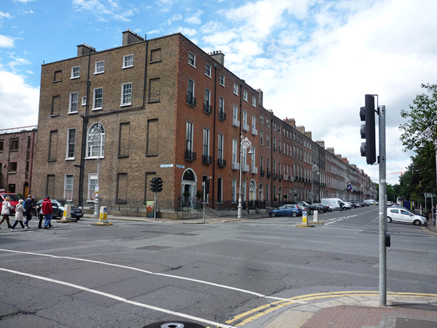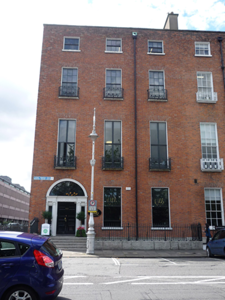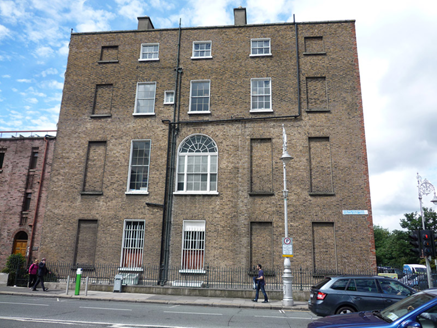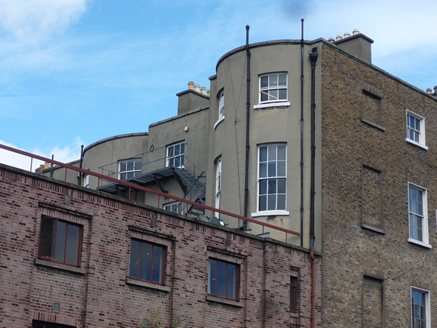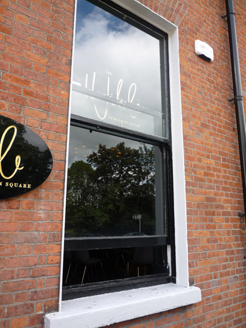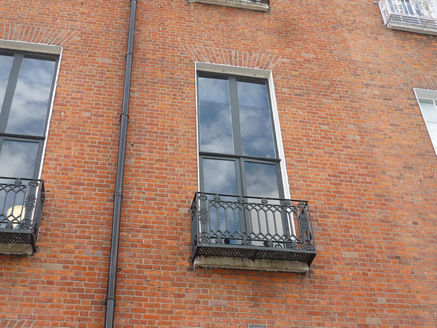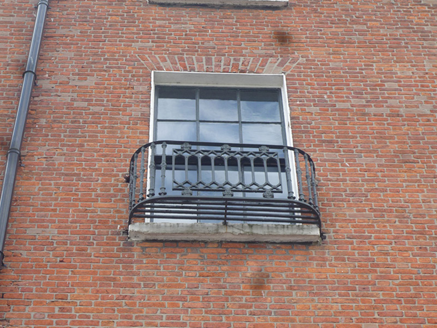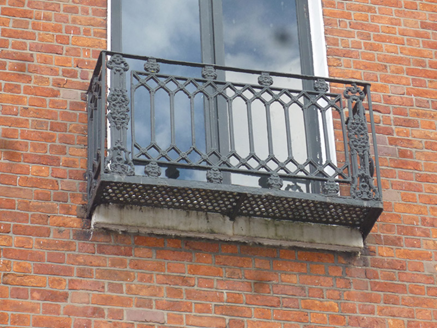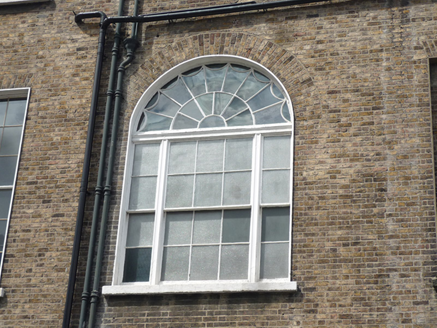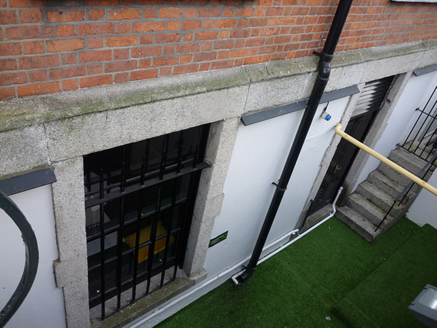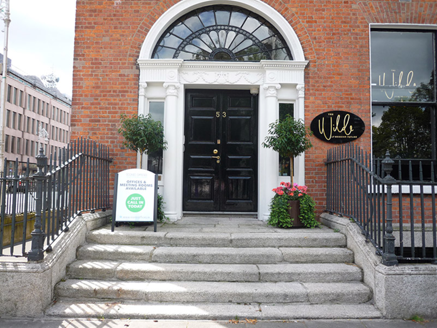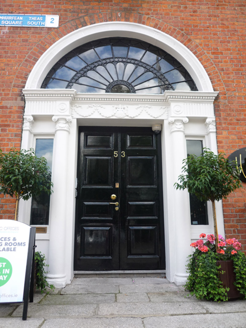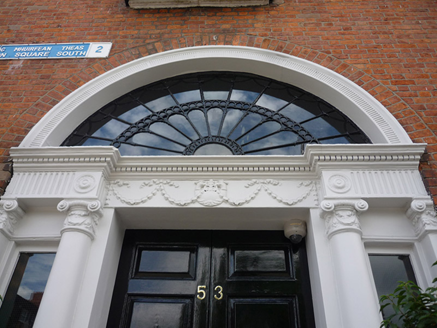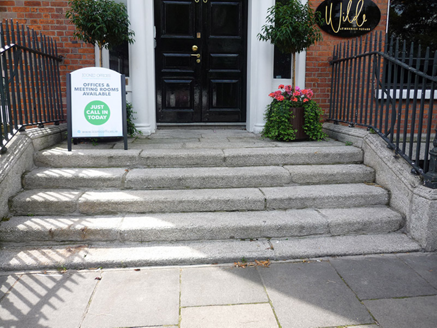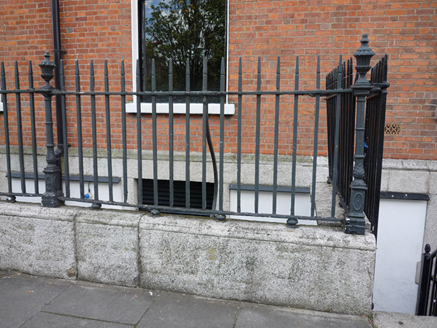Survey Data
Reg No
50100435
Rating
National
Categories of Special Interest
Architectural, Artistic, Social
Previous Name
Convent of Saint Marie Reparatrice
Original Use
House
Historical Use
Convent/nunnery
In Use As
Office
Date
1785 - 1795
Coordinates
316744, 233396
Date Recorded
29/07/2016
Date Updated
--/--/--
Description
Corner-sited three-bay four-storey former house over basement, built c. 1790 as one of pair with No. 54, having five-bay east elevation and projecting bow to east bay of rear elevation with single-bay side walls. Now in use as offices. Pitched slate roof to front, hipped to east end, behind rebuilt Flemish bond brown brick parapet with granite coping, and two hipped roofs to rear perpendicular to street, curved over bow. Rendered chimneystacks to west party wall with long rendered chimneystacks and two further rendered chimneystacks at right angles to roof of bowed bay, with clay pots. Concealed gutters and cast-iron rainwater goods. Flemish bond brown brick walls to front and east elevations on moulded granite plinth over painted ruled-and-lined rendered walling to basement, and rear elevation is rendered. Square-headed window openings, diminishing in height to upper floors, with painted rendered reveals, soldier arches and painted granite sills; exposed granite block-and-start surrounds to basement openings. Round-headed window opening to middle bay of first floor of east elevation. Front elevation has replacement casement windows to first floor and timber sliding sash windows elsewhere, three-over-three pane to top floor, six-over-six to second floor and basement and one-over-one pane to ground floor. Decorative cast-iron balconettes to first and second floors, and wrought-iron grilles to basement windows. East and rear elevations have timber sliding sash windows. East elevation has three-over-three pane to top floor, six-over-six pane to second floor, nine-over-nine pane to first floor, nine-over-one pane to ground floor, round-headed window being tripartite six-over-six pane with cobweb fanlight, bay to each end having blind openings, and ground and first floor openings to second bay back also being blind. Rear elevation has three-over-three pane windows to top floor, six-over-six pane to second and ground floors and six-pane over casements to first floor. Round-headed principal doorway with Adamesque Ionic columns, pilaster responds flanking plain sidelights, stepped frieze, fluted and with paterae over sidelights and swagged over door opening, decorative leaded batwing fanlight, fluted moulded architrave and eight-panel double-leaf timber door with brass furniture. Granite platform with five granite steps. Wrought-iron railings enclosing basement area with decorative cast-iron posts on moulded granite plinth. Replacement timber-sheeted doors access basement interior below bridged platform. Metal fire escape to rear, also serving No. 54. Casey (2005) notes good ceilings to interior. Flat-roof three-storey mid-twentieth-century building abuts rear of bowed bay.
Appraisal
No. 53 Merrion Square forms part of the eighteenth-century square developed by the Fitzwilliam Estate. The building is an elegant and well-proportioned house that makes a particularly strong contribution to the early streetscape character of the square, standing at a key corner in the South Georgian core. It is one of the largest houses on the square, 'exceptional in size, plan and ornament.' (Casey, 2005) The relatively plain front façade is enlivened by the its ornate Ionic doorcase, complete with an elaborate leaded fanlight, while the high-quality metalwork of its railings and balconettes provides additional visual and craft interest. It was likely the first building erected on this side of the square Apparently, it was built as a town residence for the Earl of Wicklow, who never lived there. The interior has what Casey regards as the best stairs hall on Merrion Square. Nos. 53-54 was used as a convent of Saint Mary Reparatrice, for which a chapel was installed to the rear in 1939. The square is one of the best-preserved Georgian streetscapes in Ireland. The north, east and south sides are lined with terraced houses of eighteenth and early nineteenth-century date, while the west side is terminated by the garden front of Leinster House. The houses maintain a relatively uniform building height and design, attributed to standards promoted in Fitzwilliam's leases. Individuality was introduced through the design of doorcases, window ironwork and interior decorative schemes. The south side of Merrion Square was initially set in large plots of twelve leases; plots were leased consecutively from east to west until the row was completed in 1791.
